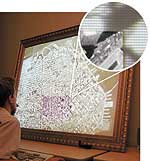|
The bottom line
At today’s
prices, a design professional should have a 19-inch or larger CRT
monitor on his or her desk—their quality, reliability, and
resolution are high, and prices are reasonable. The most costly CRTs
tend to offer better quality than their flat-screen brethren. Of
course, if desktop space is the issue, you should consider buying an
LCD if you can afford one. Prices will continue to drop and their
technology continues to improve, so these former barriers won’t be a
problem in the future. As more pressure-sensitive displays move from
the labs into the mainstream, and as more software is released that
allows for on-screen input, these interactive, haptic devices will
become as commonplace as the CRT is today— particularly for design
professionals, who often prefer drawing directly on a surface
instead of using a keyboard and mouse.

Palo Alto Research Center’s new display
lets you see both up close and in
context. |
The future will
bring us even larger displays. Architects who have been accustomed
to relatively small monitors, which require constant zooming and
panning so they can work on the small details of large buildings
projects, will be able to see their work on huge screens.
Considering the size of typical drawings or rendering and the time
it takes to manipulate through a CAD file, the need for this larger
screen doesn’t seem all that unreasonable. As the price of displays
continues to drop, conference rooms and common pinup areas will also
be benefactors of large flat-screen technology. Researchers at the
Palo Alto Research Center (formerly Xerox PARC) have been developing
something called “focus-plus-context screens,” devices that impose a
low-resolution, rear-screen-projected image over a high-resolution
image produced by a flat-panel monitor. These devices will allow
users to see one area of an image in detail, while still allowing
them to view it in its overall context. Users say these new screens
let them work much more quickly, compared to having to toggle
between a large image and its blown-up details.
This technology
experimentation could one day be of great benefit to the design
profession. Wouldn’t a 36-by-48-inch display look great on your
desk?
Page 1
| 2
| 3 | 4 | 5 | 6
Return to DIGITAL
ARCHITECT INDEX
|
